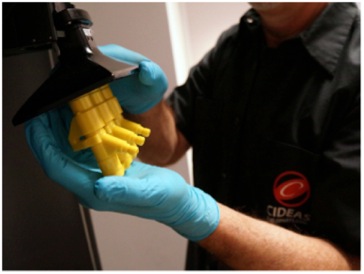
Since the announcement a year ago (almost to the day) introducing the world to the CLIP 3D printing process, from the company that was then called Carbon3D, much has been made of the speed of this process and the high levels of funding it has garnered.
Both of these factors are, indeed, worthy of note; however where this company, now simply called Carbon, aims to make significant, often overlooked, advances is with the materials it utilises!
Materials have long been cited as one of the greatest limitations of 3D printing and they are still a major hurdle in terms of breadth of palette and durability for many applications. It is for this reason that I believe Carbon is one to watch on the materials front, due in no small part to the company’s CEO & Founder, Joseph DiSimone.
It was Joseph that gave the original TED talk introducing CLIP around this time last year. I’ve never met him personally, but I have met his son, Phil, who works along side him, numerous times now. The first time I met Phil was at Euromold 2014, where, off-site and under NDA, he handed me an elastomeric 3D printed part to see what I thought. As I squished, squeezed and was challenged to try and snap the part (I couldn’t) I got quite excited — I hadn’t seen anything like it before. I also got to see the now widely watched real-time video that demonstrates the speed of the CLIP process and thus returned home from Frankfurt that year anticipating a step change.
As mentioned there are some serious investors on board with Carbon, with some serious numbers quoted. A couple may be on the 3D printing bandwagon, but I suspect the majority have cottoned on to Carbon’s serious focus on materials, backed by Joseph’s extensive experience as a materials scientist, which is what I believe gives this company an edge — one that the “me too” companies may be hard pressed to match, even if they can improve on the speed.
Despite my anticipation, it’s not been a fast roll-out, rather Carbon has been steadily and carefully building to commercial release — in terms of hardware, materials and users — and that’s no bad thing actually.
To this end the company has grown, with staff at its California facilities now numbering 135. Last year the company reported that the Ford Motor Company had been testing the CLIP platforms and materials with good results, and today Carbon is announcing an extension of its early customer program, which has now been joined by CIDEAS, Sculpteo, Technology House and WestStar Precision. The angle here is that by partnering with these leading service bureau and contract manufacturing customers, access to Carbon’s CLIP technology will be greatly increased and enable a wider range of end users to engage with the process and benefit from it, via a third party. The benefits, according to Carbon, are the ability to produce polymeric parts quickly but with the resolution, surface finish and mechanical properties required for functional prototypes and production-quality parts — all ahead of full release later this year.
Commenting on this, Joseph DeSimone expanded: “These new customers are key drivers of innovation and production across industries,” said Joseph DeSimone, CEO and Co-Founder of Carbon. “We’re excited to partner with them and offer expanded access to CLIP to further uncover application opportunities for our technology.”
While Mike Littrell, President of CIDEAS, seems to think along the same lines as me. He commented: “Carbon’s range of engineering grade materials are a game-changer in advancing what is possible with additive manufacturing.”
And just a quick note on the company changing — or rather altering — its name, I reached out to Phil DeSimone on this to see what had prompted dropping the 3D. He told me: “We updated our name this year as part of a larger evolution of our brand identity. We felt Carbon was a good refinement for us as we grow. Our customers, partners and internal teams had already been using ‘Carbon’ as a shorthand for Carbon3D so we were excited to formalize it.”
Via Carbon

